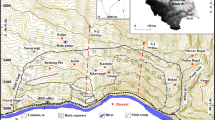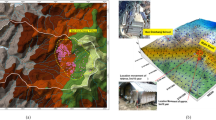Abstract
This effort is made to develop a landslide hazard map and perform the kinematic slope instability analysis of the critical sections at the Dasu dam site and its reservoir area. The study area is located at the Indus River in the Kohistan District within the highly elevated Himalayan terrain. The fragile geologic setup and high tectonic activity make this region favorable to produce frequent slope failures and landsliding events. First, a regional level landslide inventory map was created using GIS and remote-sensing tools. For this a hill shaded topographic map was created by overlapping a topographic map on to a hillshade image extracted from satellite based PALSAR Digital Elevation Model (DEM) with 12.5 m spatial resolution in GIS environment. Numerous past landsides were delineated using the expert driven knowledge of anomalous topographic expression like, crenulated contours, divergent contours, isolated topographic knobs, extended topographic ridges and arcuate headscarf evacuation areas. Total 120 landslides were marked, later a field visit was carried out for the validation of this exercise. The overall efficiency of this work was 85% which indicates that the GIS and remote sensing tools utilized for this study are reliable and effective in producing regional landslide inventory maps. Moreover, the scanline surveys were conducted at few selected locations to generate discontinuities data for the evaluation of slope instability issues by using kinematic analysis in DIPS 7.0 software. The study successfully highlights the usefulness of GIS and RS tools and in combination with kinematic analysis for landslides hazard assessment for mega projects. The outcomes of this research could serve as a guide in risk assessment and mitigation work in future to stabilize the critical slopes near Dasu dam site and along its reservoir area.



















Similar content being viewed by others
Availability of data and materials
The authors have no reservations about sharing the data and material used for this study upon request.
References
Ahmed MF, Rogers JD (2014) Creating reliable, first-approximation landslide inventory maps, using ASTER DEM data and geomorphic indicators, an example from the upper Indus River in northern Pakistan. Environ Eng Geosci 20(1):67–83
Ahmed MF, Rogers JD, Ismail HE (2015) Historic landslide dams along the Upper Indus River, Northern Pakistan. Nat Hazards Rev. https://doi.org/10.1061/(ASCE)NH.1527-6996.0000165
Banach M (1985) Geodynamika zbocza doliny Wisły w Dobrzyniu, Przegląd Geografi czny, 57(4):527–551
Brabb EE (1984) Innovative approaches to landslide hazard mapping. In: Proceedings 4th International Symposium on Landslides, Toronto, 1: 307–324
Cardinali M, Guzzetti F, Brabb, EE (1990) Preliminary map showing landslide deposits and related features in New Mexico. US Geological Survey Open File Report 90/293, 4 sheets, scale 1: 500,000
Carrara A, Cardinali M, Detti R, Guzzetti F, Pasqui V, Reichenbach P (1991) GIS techniques and statistical models in evaluating landslide hazard. Earth Surf Proc Land 16(5):427–445
Carrara A, Cardinali M, Guzzetti F, Reichenbach P (1995) Gis Technology in Mapping Landslide Hazard. In: Carrara A, Guzzetti F (eds) Geographical Information Systems in Assessing Natural Hazards. Advances in Natural and Technological Hazards Research, 5. Springer, Dordrecht. https://doi.org/10.1007/978-94-015-8404-3_8
Chalkais C, Ferentinou M, Polykretis C (2014) GIS-Based Landslide Susceptibility Mapping on the Peloponnese Peninsula, Greece. Geosciences. 4(3):176-190. https://doi.org/10.3390/geosciences4030176
Coward MP, Butler RW (1985) Thrust tectonics and the deep structure of the Pakistan Himalaya. Geology 13(6):417–420
Crozier MJ (2010) Landslide geomorphology: An argument for recognition, with examples from New Zealand. Geomorphology 120:3–15
Cruden DM, Varnes DJ (1996) Landslide types and processes. In: Turner AK, Schuster RL (eds) Landslides, investigation and mitigation, special report 247. Transportation Research Board, Washington, pp 36–75
Doyle BC, Rogers JD (2004) Seismically-induced lateral spread features in the Western New Madrid Seismic zone. Environ Eng Geosci 11(3):251–258
Feizizadeh B, Blaschke T (2013) GIS-multicriteria decision analysis for landslide susceptibility mapping: comparing three methods for the Urmia lake basin, Iran. Nat Hazard 65:2105–2128
Galli M, Ardizzone F, Cardinali M, Guzzetti F, Reichenbach P (2008) Comparing landslide inventory maps. Geomorphology, 94: 268–89
Geological Map of Pakistan (1993) Geological survey of Pakistan. Graphic Publishers, Karachi
Glade T (2001) Landslide Hazard Assessment and Historical Landslide Data — An Inseparable Couple?. In: Glade T, Albini P, Francés F (eds) The Use of Historical Data in Natural Hazard Assessments. Advances in Natural and Technological Hazards Research, vol 17. Springer, Dordrecht. https://doi.org/10.1007/978-94-017-3490-5_12
Goodman RE (1989) Introduction to rock mechanics. University of California at Berkeley, p 562
Guzzetti F, Reichenbach P, Ardizzone F, Cardinali M, Galli M (2006) Estimating the quality of landslide susceptibility models. Geomorphology 81:166–184
Guzzetti F, Cardinali M, Reichenbach P, Carrara A (2000) Comparing landslide maps: a case study in the upper Tiber River Basin, Central Italy. Envirnn Manege 25(3):245-263
Hoek E, Bray JD (1981) Rock slope engineering, 3rd edn. Engineering and Technology
Jibson RW, Harp EL (2012) Extraordinary distance limits of landslides triggered by the 2011 Mineral, Virginia. Earthq Bull Seismol Soc Am 102(6):2368–2377
Loo H (2006) Reactivation of an old landslide in response to reservoir impoundment and fluctuations. Dissertation, University of Hong Kong.
Nadim F, Kjekstad O, Peduzzi P (2006) Global landslide and avalanche hotspots. Landslides 3:159–173
Ovchinnikov GI, Trzhtsinsky JB, Pavlov SH (1999) Changes of geological environment in zones of influencing of Angaro- Jenisej Cascade Reservoirs. Izdatelstvo Nauka, Novosibirsk (in Russian)
Riemer, W (1995) Landslides and reservoirs. In: Bell DH (ed) Proc 6th Int Symp on Landslides, Christchurch, 3, Additional papers, reports, discussion, International Association of Engineering Geology. Balkema Publishers, Rotterdam, pp 213–224
Rogers JD (1980) Factors affecting hillslope profile: current topics in geomorphology, Berkeley UC, unpublished manuscript. UC Water Resources Center Archives Riverside
Rogers/Pacific Inc (1994) Report Accompanying Map of Landslides and Other Surficial Deposits of the City of Orinda, C.A. Consultant’s report for the City of Orinda Public Works Department
Schuster RL (1979) Reservoir induced landslides. Bull Int Assoc Eng Geol 20:8–15
Tahirkheli RAK, Jan MQ (1979) Preliminary Geological map of Kohistan and adjoining areas. In: Geology of Kohistan. GeoI. Bull. Univ. Peshawar (Special Issue) 11:1-187
Terzaghi K (1950) Mechanism of landslides. In: Paige S (ed) Application of geology to engineering practice (Berkey Volume). The Geological Society of America, pp 83–123
Toz G, Erdogan M (2008) 'DEM (digital elevation model) production and accuracy modeling of Dem from 1:35.000 scale aerial photographs. Int Arch Photogramm Remote Sens and Spatial Inf Sci 37(1):775-780
Van Den Eeckhaut M, Moeyersons J, Nyssen J, Abraha A, Poesen J, Haile M, Deckers J (2009) Spatial patterns of old, deep-seated landslides: a case-study in the northern Ethiopian highlands. Geomorphology 105:239–252
Varnes, D.J (1984) Landslide hazard zonation: a review of principles and practice. Commission of Landslides of the IAEG UNESCO, Natural Hazards 3:61
Wyllie DC, Mah CW (2004) Rock slope engineering (4edition). Spon Press, London
Acknowledgements
The authors are thankful to the respected reviewers for their valuable comments to improve the quality of this manuscript. We further extend our appreciation to University of Engineering and Technology and Water and Power Development Authority (WAPDA) for their support to conduct this research work.
Author information
Authors and Affiliations
Contributions
The first author MFA conceived the idea to conduct this research. Later he supervised the research work and partly written the article. The second author FS performed this research work under the supervision of first author. The 3rd author EM (Assistant Professor Civil Engg Department UET Lahore) greatly helped in conducting the scanline surveys in the field and later in the revision of this article in methodology and introduction section. The authors have no conflict of interest in publishing this resasrch work.
Corresponding author
Ethics declarations
Competing interests
The authors declare no competing interests.
Additional information
Publisher's Note
Springer Nature remains neutral with regard to jurisdictional claims in published maps and institutional affiliations.
Rights and permissions
Springer Nature or its licensor (e.g. a society or other partner) holds exclusive rights to this article under a publishing agreement with the author(s) or other rightsholder(s); author self-archiving of the accepted manuscript version of this article is solely governed by the terms of such publishing agreement and applicable law.
About this article
Cite this article
Ahmed, M.F., Sher, F. & Mehmood, E. Evaluation of landslide hazards potential at Dasu dam site and its reservoir area. Environ Earth Sci 82, 183 (2023). https://doi.org/10.1007/s12665-023-10789-3
Received:
Accepted:
Published:
DOI: https://doi.org/10.1007/s12665-023-10789-3




